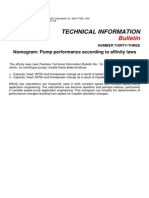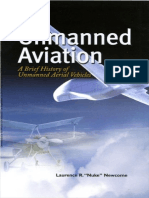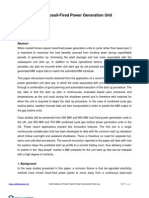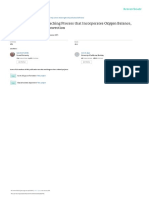0 ratings0% found this document useful (0 votes)
14 viewsOptimizing Electric Submersible Pump Replacement Costs N.W. Kupsch
Optimizing Electric Submersible Pump Replacement Costs N.W. Kupsch
Uploaded by
Ghery Yoseph GirsangThis document discusses an electric submersible pump (ESP) replacement program at Amoco Canada Petroleum Company that aims to reduce costs. Through cleaning and testing used ESP motors and pumps, over 450 pumps and 220 motors have been requalified for reuse, saving over $2 million compared to traditional replacement methods. Key factors in the program's success include a high requalification rate from testing and low testing costs.
Copyright:
© All Rights Reserved
Available Formats
Download as PDF, TXT or read online from Scribd
Optimizing Electric Submersible Pump Replacement Costs N.W. Kupsch
Optimizing Electric Submersible Pump Replacement Costs N.W. Kupsch
Uploaded by
Ghery Yoseph Girsang0 ratings0% found this document useful (0 votes)
14 views5 pagesThis document discusses an electric submersible pump (ESP) replacement program at Amoco Canada Petroleum Company that aims to reduce costs. Through cleaning and testing used ESP motors and pumps, over 450 pumps and 220 motors have been requalified for reuse, saving over $2 million compared to traditional replacement methods. Key factors in the program's success include a high requalification rate from testing and low testing costs.
Original Description:
Choosing ESP models
Original Title
ESP models
Copyright
© © All Rights Reserved
Available Formats
PDF, TXT or read online from Scribd
Share this document
Did you find this document useful?
Is this content inappropriate?
This document discusses an electric submersible pump (ESP) replacement program at Amoco Canada Petroleum Company that aims to reduce costs. Through cleaning and testing used ESP motors and pumps, over 450 pumps and 220 motors have been requalified for reuse, saving over $2 million compared to traditional replacement methods. Key factors in the program's success include a high requalification rate from testing and low testing costs.
Copyright:
© All Rights Reserved
Available Formats
Download as PDF, TXT or read online from Scribd
Download as pdf or txt
0 ratings0% found this document useful (0 votes)
14 views5 pagesOptimizing Electric Submersible Pump Replacement Costs N.W. Kupsch
Optimizing Electric Submersible Pump Replacement Costs N.W. Kupsch
Uploaded by
Ghery Yoseph GirsangThis document discusses an electric submersible pump (ESP) replacement program at Amoco Canada Petroleum Company that aims to reduce costs. Through cleaning and testing used ESP motors and pumps, over 450 pumps and 220 motors have been requalified for reuse, saving over $2 million compared to traditional replacement methods. Key factors in the program's success include a high requalification rate from testing and low testing costs.
Copyright:
© All Rights Reserved
Available Formats
Download as PDF, TXT or read online from Scribd
Download as pdf or txt
You are on page 1of 5
OPTIMIZING ELECTRIC SUBMERSIBLE PUMP
REPLACEMENT COSTS
N.W. KUPSCH
this article begins on the next page F
JCPT90-05-04 OPERATIONS Optimizing electric submersible pump replacement costs NATHAN W. KUPSCH Amoco Canada Petroleum Co. Ltd. ABSTRACT Electric submersible pumps (ESPS) have made a significant con- tribution to the petroleum industry as an economic means of ar- tificial lift. As current depressed oil prices linger, it has become especially critical that costs associated with operating ESPs be kept to a minimum. One method, which has resulted in a great deal of success for Amoco Canada, has been qualifying used motors and pumps for re-use through cleaning and testing procedures. Among
Amoco Canada's operations are two large fields,- the South Swan Hill Unit and the Nipisi Gilwood Unit No. 1. Together, a total of 235 electric submersible pumps are i . n serv- ice. As ESPsfail downhole, equipment is examinedforpolential testing application. To the end of June 1989, 457pumps have been cleaned and tested while 221 motors have also been put through the test program. A high requalijication rate and in@nsive testing cost have combinedfor substantial savings over traditional repair procedures. The success of the program has been further enhanced by encouraging ESP performance
from equipment rerun subse- quent to being cleaned and tested. Introduction Amoco Canada Petroleum Company Ltd. is the U@t Operator of two major miscible flood projects. The locations of these fields are shown in Figure 1. The South Swan Hills Unit is located 225 km northwest of Edmonton, Alberta, and comprises 188 producing wells with 70 injection wells. The 124 electric submersible pump locations account for almost 9707o of the 30 000 M3 per day aver- age fluid volume. Production is from the Swan Hills formation of the Beaverhill Lake Group, a limestone reef complex. Bottom- hole
temperature averages 1120C at a depth of 2 500 m KB. The Nipisi Gilwood Unit No. I is located approximately 350 km north of Edmonton. The average Unit fluid production is 23 500 M3 per day. Included in the 230 producing wells are I I I ESPs which are responsible for 9307o of this volume. An addi- tional 74 wells are used for injection. The producing reservoir is the Gilwood (sandstone) formation at a depth of 1 700 m and BHT of 600C. During the past few years, an average of 125 ESP replacements have taken place annually in the above locations. Included in the $55,000 average
replacement cost were ESP equipment expenses of $28,000 each. This resulted in an annual expenditure of ap- proximately $3,500,000 for ESP repair and/or purchase. In April 1987, a used pump and motor testing program was ir-dtiated, s@ar to that described by D.L. Divine(l). In the 26 months since that time, ESP replacement expenditures have been reduced by almost $2 milhon. Keywords: Electric submersible pump, ESP, Pump test, Motor test, Cost reduction, ESP run life, Equipment requalification. Paper reviewed and accepted for publication by the Editorial September-October 1990, Volume 29,
No. 5 ESP Operations Amoco Canada replaces ESPs through the most economic means available. This has historically been with new equipment purchase and/or flat rate repairs. Research into the failures experienced showed that while one component failed, companion equipment was often in good condition and could be re-used. Standby in- ventories have been maintained separately for each Unit in order to minimize costs and eliminate deferred production due to the unavailability of equipment. This inventory provided an ideal sit- uation for testing motors and pumps, because replacement pieces
could be taken from stock with no production loss incurred while waiting for test results. The first ESPs tested by Amoco Canada for potential re-use were done iii the U.S. during mid-1986. Made up primarily of equipment with short r-un lives, the group was tested with very successful results. With the significant cost savings r@ on these pieces, fur-tber applications were sought. Amoco owned a large amount of unrepaired ESP equipment as a result of purchasing new pumps when economics were favourable over repair and/or exchange. Most of this equipment had simply been pulled and
stored, some for up to three years. A total of 108 pump housings and 46 motors were tested from this stock after a very limited selection process. Although experiencing a lower success rate in testing, cost savings still proved very attractive. With industry ac- ceptance of ihe testing concepts, major ESP vendors then decided to offer similar services locally. At this time, Amoco Canada in- itiated its routine pump and motor testing program. Submersible Pump Testing Selection of Pumps for Testing The initial st@ep in the pump testing program is to identify those pumps which are suitable
candidates for the testing procedure. Various factors may influence the success ratio of the program. Among these may be: run life of the equipment; presence of abra- sives (sand); foreign material plugging (scale, asphaltene); fluid production rates relative to pump size; mechanical condition when pulled; and, time and method of storage. In order to qualify a pump for testing, the above points should be evaluated to ensure a reasonable degree of confidence in achiev- ing a successful test. In the early stages of a testing program, all pumps may be tested in order to set selection
criteria. Although a lower percentage may meet specifications, the low testing cost should still make the program economic. The most important information used to select pumps for test- ing is data obtained when the ESP is pulled. Bent housidgs, se- vere corrosion, broken shafts, twisted splines, bushing wear or excessive shaft play may immediately disqualify a pump from the test program. @le a seized pump may indicate potential damage, often the cle@ng procedure can free it and an acceptable test may Board of The Journal of Canadian Petroleum Technology. 63
You might also like
- ENVI Met TutorialDocument45 pagesENVI Met TutorialOliveiro Alvarado75% (8)
- The Wonderful Flight To The Mushroom PlanetDocument20 pagesThe Wonderful Flight To The Mushroom PlanetAbel Reyes Elorza0% (2)
- ESP CostsDocument180 pagesESP Costshermit44535No ratings yet
- Peerless Pump Tech BulletinsDocument176 pagesPeerless Pump Tech BulletinsWilhelm ThorleyNo ratings yet
- 10 2514@4 868894Document181 pages10 2514@4 868894amerNo ratings yet
- Long Stroke Pumping UnitDocument10 pagesLong Stroke Pumping UnitsayidNo ratings yet
- Optimised Autonomous Power SystemDocument14 pagesOptimised Autonomous Power SystemFilmon TNo ratings yet
- SPE-68789-MS One PetroDocument5 pagesSPE-68789-MS One PetroAlex ZamanNo ratings yet
- 5.0 Simulation of Reservoirs and Energy Production: Consolidated ReportDocument11 pages5.0 Simulation of Reservoirs and Energy Production: Consolidated ReportduchangenicolasNo ratings yet
- Spe 206265 MsDocument14 pagesSpe 206265 MsAlfonso RamosNo ratings yet
- SLB Premium ReshearchDocument13 pagesSLB Premium ReshearchJay PatelNo ratings yet
- How Do You Save American Resources & Reduce Global Warming?: Power Plants: The New American Hero!Document2 pagesHow Do You Save American Resources & Reduce Global Warming?: Power Plants: The New American Hero!yousaf_zai_khan81995No ratings yet
- SPE-173996-MS Solar-Generated Steam For Oil Recovery: Process Integration Options, Net Energy Fraction, and Carbon Market ImpactsDocument20 pagesSPE-173996-MS Solar-Generated Steam For Oil Recovery: Process Integration Options, Net Energy Fraction, and Carbon Market ImpactsEvelynQuinteroNo ratings yet
- FILE - 20201025 - 102401 - PAPER - GHGT14 - 948 - Flexibility - Efficiency - Steam - CCSDocument10 pagesFILE - 20201025 - 102401 - PAPER - GHGT14 - 948 - Flexibility - Efficiency - Steam - CCSNGUYEN QUANGNo ratings yet
- SPE-196323-MS Improving Horizontal Well Performance With Bottom Feeder Intake On Electric Submersible Pump in Gassy Wells, Offshore North West JavaDocument9 pagesSPE-196323-MS Improving Horizontal Well Performance With Bottom Feeder Intake On Electric Submersible Pump in Gassy Wells, Offshore North West Javaimam zulkipliNo ratings yet
- Eng Peegcu Fuel Cell Application Centre of InnovationDocument9 pagesEng Peegcu Fuel Cell Application Centre of InnovationNazeer KhanNo ratings yet
- Cost-Effectiveness of Solar Water ProductionDocument11 pagesCost-Effectiveness of Solar Water ProductionHarshit AgarwalNo ratings yet
- Kal War 2017Document10 pagesKal War 2017khusnul9No ratings yet
- To Improve Thermal Efficiency of 27mw CoDocument24 pagesTo Improve Thermal Efficiency of 27mw Codixie0630No ratings yet
- Effect of Fluid Forces On Vertical Pump Vibrations: Condition Monitoring Technical Services (TS)Document3 pagesEffect of Fluid Forces On Vertical Pump Vibrations: Condition Monitoring Technical Services (TS)JAY PARIKHNo ratings yet
- FluidsDesignProjectReport DesDocument9 pagesFluidsDesignProjectReport DesJunaid YNo ratings yet
- Test of Polymer Electrolyte Membrane Fuel Cell - Uninterruptible Power Supply For Electric Utility Battery Replacement MarketsDocument48 pagesTest of Polymer Electrolyte Membrane Fuel Cell - Uninterruptible Power Supply For Electric Utility Battery Replacement MarketsSebastião Jorge dos SantosNo ratings yet
- Electrical Submersible PumpDocument8 pagesElectrical Submersible Pumpmsyahir_chNo ratings yet
- Rope-Pump System Modelling Using Renewable Power CombinationsDocument8 pagesRope-Pump System Modelling Using Renewable Power CombinationstongaiNo ratings yet
- IPTC 20137 AbstractDocument9 pagesIPTC 20137 AbstractNileshgordeNo ratings yet
- Optimization of Startups - RTPDocument11 pagesOptimization of Startups - RTPmoh1234buk100% (1)
- Dany PR DanaDocument8 pagesDany PR DanaUsmanAliNo ratings yet
- ISEP Economics Study SummaryDocument8 pagesISEP Economics Study Summaryaliscribd46No ratings yet
- Test of Hydraulic Jet Pump in The Balam 91 WellDocument10 pagesTest of Hydraulic Jet Pump in The Balam 91 WellHaaram Pineda PinedaNo ratings yet
- 11 Pumped Storage Schemes (Document13 pages11 Pumped Storage Schemes (tsinghal_19No ratings yet
- Egenerative Shock Absorber For Hybrid Cars: C. M. Pramodh, S. R. ShankapalDocument8 pagesEgenerative Shock Absorber For Hybrid Cars: C. M. Pramodh, S. R. ShankapalArun GargNo ratings yet
- Intermittent PumpingDocument8 pagesIntermittent PumpingAvanish ChaubeyNo ratings yet
- KSB BFB Pump 2 PDFDocument14 pagesKSB BFB Pump 2 PDFRaja RamachandranNo ratings yet
- Integrated Solar Power Plants (ISCC)Document13 pagesIntegrated Solar Power Plants (ISCC)carzanteNo ratings yet
- Design Optimization of Photovoltaic Powered Water PDFDocument15 pagesDesign Optimization of Photovoltaic Powered Water PDF544057No ratings yet
- Method of Equivalencing For A Large Wind Power Plant With Multiple Turbine RepresentationDocument11 pagesMethod of Equivalencing For A Large Wind Power Plant With Multiple Turbine RepresentationAlberto JimenezNo ratings yet
- Chapter 2Document16 pagesChapter 2Engineers GalleryNo ratings yet
- A PROJECT REPORT Final Year 2Document12 pagesA PROJECT REPORT Final Year 2aniket bobadeNo ratings yet
- Optimization of Plant Output: 10.1 Principal VariablesDocument12 pagesOptimization of Plant Output: 10.1 Principal VariablesproteccionesNo ratings yet
- Iare Eop PPTDocument51 pagesIare Eop PPTProf Dr. M Mahbububur RahmanNo ratings yet
- ReviewPaper WO QuillbotDocument9 pagesReviewPaper WO QuillbotHet PatelNo ratings yet
- Feasibility Study: Generating Electricity From Traditional WindmillsDocument16 pagesFeasibility Study: Generating Electricity From Traditional Windmillsap00No ratings yet
- Exhaust Gas Heat Recovery Power GenerationDocument52 pagesExhaust Gas Heat Recovery Power GenerationabhinavkarthickNo ratings yet
- Cmpadpp B 007Document9 pagesCmpadpp B 007Ross ZhouNo ratings yet
- The Cost of Electricity Generation From Natural Gas-Fired Power PlantsDocument6 pagesThe Cost of Electricity Generation From Natural Gas-Fired Power PlantsThuan Huynh MinhNo ratings yet
- Comparative Analysis For Various RFB Chemistries - Cawford2015Document12 pagesComparative Analysis For Various RFB Chemistries - Cawford2015SureshBharadwajNo ratings yet
- Wind Parks - Hydro Pumping Coordinated Operation: Application To The Portuguese SystemDocument6 pagesWind Parks - Hydro Pumping Coordinated Operation: Application To The Portuguese SystemChandra ShettyNo ratings yet
- On The Influence of Viscosity On Esp Performance - Valdir EstevamDocument8 pagesOn The Influence of Viscosity On Esp Performance - Valdir EstevamGaldir RegesNo ratings yet
- Full Report To CheckDocument10 pagesFull Report To Checkkaushik patelNo ratings yet
- Energy Management of Fuel Cell Battery Supercapacitor Hybrid Power Sources Using Model Predictive ControlDocument11 pagesEnergy Management of Fuel Cell Battery Supercapacitor Hybrid Power Sources Using Model Predictive ControlAnonymous xaeuoo4No ratings yet
- Pumps Used As Turbines Power Recovery Energy EfficDocument13 pagesPumps Used As Turbines Power Recovery Energy EfficJhonis CoelhoNo ratings yet
- Solar-Powered Chemical Injection Pumps: DescriptionDocument7 pagesSolar-Powered Chemical Injection Pumps: DescriptionMatter ExpertNo ratings yet
- Solar-Powered Chemical Injection Pumps: DescriptionDocument7 pagesSolar-Powered Chemical Injection Pumps: DescriptionMatter ExpertNo ratings yet
- Solar-Powered Chemical Injection Pumps: DescriptionDocument7 pagesSolar-Powered Chemical Injection Pumps: DescriptionMatter ExpertNo ratings yet
- SPE 128974 Single String Packerless ESP Gas Lift Hybrid Optimizing Production and Minimizing LossDocument8 pagesSPE 128974 Single String Packerless ESP Gas Lift Hybrid Optimizing Production and Minimizing LossChristian BimoNo ratings yet
- Description of HOMER Software - An Optimal Analysis ToolDocument17 pagesDescription of HOMER Software - An Optimal Analysis Toolanon_849607662No ratings yet
- Integrated Variable Speed DrivesDocument14 pagesIntegrated Variable Speed DrivesulatbookNo ratings yet
- Energy and Exergy Analysis of A Super Critical Thermal Power Plant atDocument15 pagesEnergy and Exergy Analysis of A Super Critical Thermal Power Plant atfrancovlsc3No ratings yet
- The PV Generator Single Phase Induction Motor The Battery The DC Regulator The DC/AC InverterDocument55 pagesThe PV Generator Single Phase Induction Motor The Battery The DC Regulator The DC/AC InverterRenu DahiyaNo ratings yet
- Vibration Analysis of ESPDocument13 pagesVibration Analysis of ESPNelton AlarcónNo ratings yet
- Gas-Engines and Producer-Gas Plants A Practice Treatise Setting Forth the Principles of Gas-Engines and Producer Design, the Selection and Installation of an Engine, Conditions of Perfect Operation, Producer-Gas Engines and Their Possibilities, the Care of Gas-Engines and Producer-Gas Plants, with a Chapter on Volatile Hydrocarbon and Oil EnginesFrom EverandGas-Engines and Producer-Gas Plants A Practice Treatise Setting Forth the Principles of Gas-Engines and Producer Design, the Selection and Installation of an Engine, Conditions of Perfect Operation, Producer-Gas Engines and Their Possibilities, the Care of Gas-Engines and Producer-Gas Plants, with a Chapter on Volatile Hydrocarbon and Oil EnginesNo ratings yet
- Equipment List: Item Description Price/U Quantity Availability Reference NotesDocument3 pagesEquipment List: Item Description Price/U Quantity Availability Reference Notesyusuf emadNo ratings yet
- A Model of The Dump Leaching Process That IncorporDocument9 pagesA Model of The Dump Leaching Process That IncorporFrancisco CabreraNo ratings yet
- HKDSE Chemistry A Modern View (Book 1) Answers - ScribdDocument2 pagesHKDSE Chemistry A Modern View (Book 1) Answers - ScribdOscar TsangNo ratings yet
- Your-V12 Vantage RoadsterDocument16 pagesYour-V12 Vantage RoadsteraryankachhadiaNo ratings yet
- PART C - EARTHWORK - DPWH Accredited Contractors Materials EngineerDocument4 pagesPART C - EARTHWORK - DPWH Accredited Contractors Materials EngineerJeff D. AgustinNo ratings yet
- IRigBlueBoardApp Iphone User ManualDocument12 pagesIRigBlueBoardApp Iphone User ManualfedoerigoNo ratings yet
- Barhorst Cates2018Document24 pagesBarhorst Cates2018486521366987qNo ratings yet
- Bhsa Inggris'Document5 pagesBhsa Inggris'Dwi NovianaNo ratings yet
- 10 Mechanical Equipment, Attachment PDFDocument8 pages10 Mechanical Equipment, Attachment PDFPeter BrickNo ratings yet
- unknown - Craik - 1998 - The Hippocratic Treatise on Anatomy - - 516гэщDocument33 pagesunknown - Craik - 1998 - The Hippocratic Treatise on Anatomy - - 516гэщsümeyya biverNo ratings yet
- HALO Recessed Product Selection GuideDocument8 pagesHALO Recessed Product Selection GuideDong ZhangNo ratings yet
- The Royal Family Copper Silver Gold ReferencesDocument10 pagesThe Royal Family Copper Silver Gold Referenceskrish_cvr2937No ratings yet
- RAC Lecture 3 Applications of Refrigeration Air ConditioningDocument20 pagesRAC Lecture 3 Applications of Refrigeration Air ConditioningBryan ScofieldNo ratings yet
- Problem of UnfruitfulnessDocument6 pagesProblem of UnfruitfulnessRockyNo ratings yet
- 1.timing Optimization Techniques: 1. MappingDocument152 pages1.timing Optimization Techniques: 1. MappingPraveen Kumar100% (1)
- 2.3 GHZ To 4.0 GHZ Watt RF Driver Amplifier: Data SheetDocument16 pages2.3 GHZ To 4.0 GHZ Watt RF Driver Amplifier: Data SheetJuan HernándezNo ratings yet
- 2GC4Document7 pages2GC4ddddddddeNo ratings yet
- Mechanical Engineering Manufacturing.149Document1 pageMechanical Engineering Manufacturing.149Anonymous QvIxEazXGdNo ratings yet
- Meter L&TDocument12 pagesMeter L&TnenusakNo ratings yet
- 1-8 Practice - BDocument2 pages1-8 Practice - BStanleyNo ratings yet
- Sowing Into The AnointingDocument9 pagesSowing Into The AnointingKoutosuisse100% (1)
- Levels of PreventionDocument23 pagesLevels of Preventionkuruvagadda sagar100% (1)
- How Ayurveda Helped Me With Hair LossDocument10 pagesHow Ayurveda Helped Me With Hair Losssterling goinNo ratings yet
- Final Proof - International Conference On Multi-Disciplinary Approach Towards Sustainable Development Anushandhan 2019 21st-22nd February, 2019Document140 pagesFinal Proof - International Conference On Multi-Disciplinary Approach Towards Sustainable Development Anushandhan 2019 21st-22nd February, 2019sharath100% (1)
- Viscometer Manual PDFDocument47 pagesViscometer Manual PDFBalqis yasinNo ratings yet
- Immunization StatusDocument21 pagesImmunization StatusAubery RongNo ratings yet
- Case Presentation DVTDocument26 pagesCase Presentation DVTimad mokalledNo ratings yet

























































































